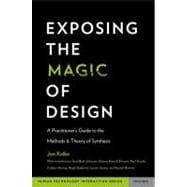
What is included with this book?
| Introduction | p. xi |
| A Lack of Method in Practice Leads to Problems | p. xii |
| The Goals of This Text | p. xv |
| The Immediacy of This Text | p. xvii |
| What Is Synthesis? | p. 1 |
| A Theory of Synthesis | p. 03 |
| Understanding How People Solve Problems | p. 04 |
| Acting on an Informed Hunch | p. 08 |
| Making a Judgment | p. 08 |
| Using Partial or Incomplete Information | p. 09 |
| Understanding, and Breaking, Constraints | p. 09 |
| Sensemaking, Frames, Models, and Patterns | p. 11 |
| The Role of Perspective in Framing Situations | p. 13 |
| The Importance of Models in Sensemaking | p. 15 |
| Mental Models as a Specific Type of Cognitive Representation | p. 17 |
| The Nature of Patterns on Our Experiences | p. 20 |
| Abductive Reasoning | p. 23 |
| Design Synthesis in a Business Context | p. 29 |
| The Value of Synthesis in Driving Innovation | p. 31 |
| What Is Innovation? | p. 37 |
| Design Synthesis Links Innovation Research and Design | p. 38 |
| The Culture of Synthesis | p. 41 |
| Challenging Constraints and Questioning Purpose | p. 43 |
| Being Playful | p. 46 |
| Experiencing Flow | p. 50 |
| Using Visualization as a Primary Mechanism of Thought | p. 54 |
| Changing a Prohibitive Culture | p. 56 |
| Methods and Applicability | p. 59 |
| Methods for Making Meaning out of Data | p. 63 |
| Externalizing the Process (Get out of Your Laptop!) | p. 63 |
| Using Visual Design to Clean up the Mess | p. 65 |
| Organizing to Produce Semantic Relationships | p. 65 |
| Prioritizing the Data to Emphasize What Is Important | p. 66 |
| Judging the Data to Reduce the Quantity | p. 66 |
| Enhancing the Data through "Best Guess" | p. 66 |
| Intuitive Leaps For Example: Getting to Meaning through Story | p. 67 |
| Method: Affinity Diagramming | p. 76 |
| How to Apply This Method | p. 76 |
| For Example: Parallel Clustering | p. 79 |
| Method: Flow Diagramming | p. 86 |
| How to Apply This Method | p. 90 |
| For Example: The Flow through a Hunter Fan Thermostat | p. 94 |
| Methods for Building an Experience Framework | p. 101 |
| Telling a Story | p. 102 |
| Changing the Scale | p. 102 |
| Shifting the Placements | p. 103 |
| Method: Concept Mapping | p. 104 |
| How to Apply This Method | p. 107 |
| For Example: Using Concept Maps in Product Development | p. 109 |
| Method: Forced Semantic Zoom ("Ecosystem Mapping") | p. 125 |
| How to Apply This Method | p. 128 |
| For Example: Breakpoint Diagrams and Other Tools for Transitions | p. 136 |
| Method: Forced Temporal Zoom ("Customer Journey Mapping") | p. 147 |
| How to Apply This Method | p. 147 |
| For Example: The Emotional Touch Points of Shopping | p. 155 |
| Methods for Creating Empathy and Insight | p. 159 |
| Understanding Chasm 3: Empathy and Insight | p. 159 |
| Method: Reframing | p. 160 |
| How to Apply This Method | p. 162 |
| Method: Insight Combination | p. 164 |
| How to Apply This Method | p. 166 |
| Conclusion | p. 169 |
| Glossary | p. 171 |
| Works Cited | p. 173 |
| Index | p. 177 |
| Table of Contents provided by Ingram. All Rights Reserved. |
The New copy of this book will include any supplemental materials advertised. Please check the title of the book to determine if it should include any access cards, study guides, lab manuals, CDs, etc.
The Used, Rental and eBook copies of this book are not guaranteed to include any supplemental materials. Typically, only the book itself is included. This is true even if the title states it includes any access cards, study guides, lab manuals, CDs, etc.